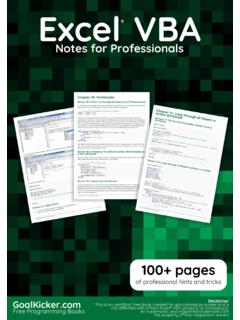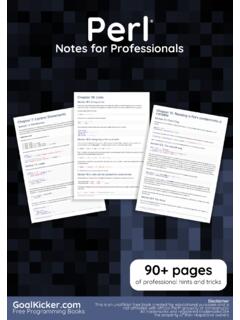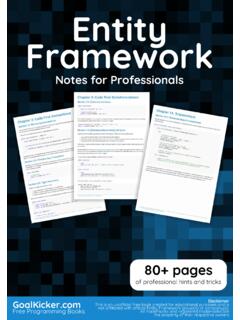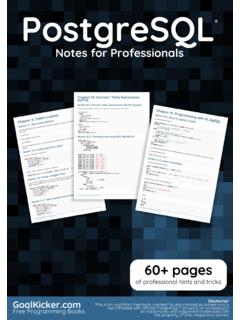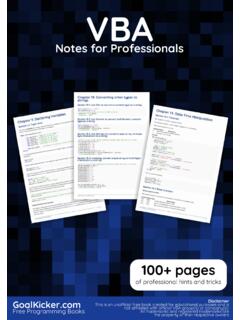Transcription of SQL Notes for Professionals - goalkicker.com
1 SQLN otes for ProfessionalsSQLN otes for Programming BooksDisclaimerThis is an uno cial free book created for educational purposes and isnot a liated with o cial SQL group(s) or company(s).All trademarks and registered trademarks arethe property of their respective owners100+ pagesof professional hints and tricksContentsAbout 1 .. Chapter 1: Getting started with SQL 2 .. Section : Overview 2 .. Chapter 2: Identifier 3 .. Section : Unquoted identifiers 3 .. Chapter 3: Data Types 4 .. Section : DECIMAL and NUMERIC 4 .. Section : FLOAT and REAL 4 .. Section : Integers 4.
2 Section : MONEY and SMALLMONEY 4 .. Section : BINARY and VARBINARY 4 .. Section : CHAR and VARCHAR 5 .. Section : NCHAR and NVARCHAR 5 .. Section : UNIQUEIDENTIFIER 5 .. Chapter 4: NULL 6 .. Section : Filtering for NULL in queries 6 .. Section : Nullable columns in tables 6 .. Section : Updating fields to NULL 6 .. Section : Inserting rows with NULL fields 7 .. Chapter 5: Example Databases and Tables 8 .. Section : Auto Shop Database 8 .. Section : Library Database 10 .. Section : Countries Table 13 .. Chapter 6: SELECT 14 .. Section : Using the wildcard character to select all columns in a query 14.
3 Section : SELECT Using Column Aliases 15 .. Section : Select Individual Columns 18 .. Section : Selecting specified number of records 19 .. Section : Selecting with Condition 20 .. Section : Selecting with CASE 20 .. Section : Select columns which are named after reserved keywords 21 .. Section : Selecting with table alias 21 .. Section : Selecting with more than 1 condition 22 .. Section : Selecting without Locking the table 23 .. Section : Selecting with Aggregate functions 23 .. Section : Select with condition of multiple values from column 24.
4 Section : Get aggregated result for row groups 24 .. Section : Selection with sorted Results 25 .. Section : Selecting with null 25 .. Section : Select distinct (unique values only) 25 .. Section : Select rows from multiple tables 26 .. Chapter 7: GROUP BY 27 .. Section : Basic GROUP BY example 27 .. Section : Filter GROUP BY results using a HAVING clause 28 .. Section : USE GROUP BY to COUNT the number of rows for each unique entry in a given column28 .. Section : ROLAP aggregation (Data Mining) 29 .. Chapter 8: ORDER BY 31 .. Section : Sorting by column number (instead of name) 31.
5 Section : Use ORDER BY with TOP to return the top x rows based on a column's value 31 .. Section : Customizeed sorting order 32 .. Section : Order by Alias 32 .. Section : Sorting by multiple columns 33 .. Chapter 9: AND & OR Operators 34 .. Section : AND OR Example 34 .. Chapter 10: CASE 35 .. Section : Use CASE to COUNT the number of rows in a column match a condition 35 .. Section : Searched CASE in SELECT (Matches a boolean expression) 36 .. Section : CASE in a clause ORDER BY 36 .. Section : Shorthand CASE in SELECT 36 .. Section : Using CASE in UPDATE 37.
6 Section : CASE use for NULL values ordered last 37 .. Section : CASE in ORDER BY clause to sort records by lowest value of 2 columns 38 .. Chapter 11: LIKE operator 39 .. Section : Match open-ended pattern 39 .. Section : Single character match 40 .. Section : ESCAPE statement in the LIKE-query 40 .. Section : Search for a range of characters 41 .. Section : Match by range or set 41 .. Section : Wildcard characters 41 .. Chapter 12: IN clause 43 .. Section : Simple IN clause 43 .. Section : Using IN clause with a subquery 43 .. Chapter 13: Filter results using WHERE and HAVING 44.
7 Section : Use BETWEEN to Filter Results 44 .. Section : Use HAVING with Aggregate Functions 45 .. Section : WHERE clause with NULL/NOT NULL values 45 .. Section : Equality 46 .. Section : The WHERE clause only returns rows that match its criteria 46 .. Section : AND and OR 46 .. Section : Use IN to return rows with a value contained in a list 47 .. Section : Use LIKE to find matching strings and substrings 47 .. Section : Where EXISTS 48 .. Section : Use HAVING to check for multiple conditions in a group 48 .. Chapter 14: SKIP TAKE (Pagination) 50.
8 Section : Limiting amount of results 50 .. Section : Skipping then taking some results (Pagination) 50 .. Section : Skipping some rows from result 51 .. Chapter 15: EXCEPT 52 .. Section : Select dataset except where values are in this other dataset 52 .. Chapter 16: EXPLAIN and DESCRIBE 53 .. Section : EXPLAIN Select query 53 .. Section : DESCRIBE tablename; 53 .. Chapter 17: EXISTS CLAUSE 54 .. Section : EXISTS CLAUSE 54 .. Chapter 18: JOIN 55 .. Section : Self Join 55 .. Section : Di erences between inner/outer joins 56 .. Section : JOIN Terminology: Inner, Outer, Semi, 59.
9 Section : Left Outer Join 69 .. Section : Implicit Join 70 .. Section : CROSS JOIN 71 .. Section : CROSS APPLY & LATERAL JOIN 72 .. Section : FULL JOIN 73 .. Section : Recursive JOINs 74 .. Section : Basic explicit inner join 74 .. Section : Joining on a Subquery 75 .. Chapter 19: UPDATE 76 .. Section : UPDATE with data from another table 76 .. Section : Modifying existing values 77 .. Section : Updating Specified Rows 77 .. Section : Updating All Rows 77 .. Section : Capturing Updated records 77 .. Chapter 20: CREATE Database 78 .. Section : CREATE Database 78.
10 Chapter 21: CREATE TABLE 79 .. Section : Create Table From Select 79 .. Section : Create a New Table 79 .. Section : CREATE TABLE With FOREIGN KEY 79 .. Section : Duplicate a table 80 .. Section : Create a Temporary or In-Memory Table 80 .. Chapter 22: CREATE FUNCTION 82 .. Section : Create a new Function 82 .. Chapter 23: TRY/CATCH 83 .. Section : Transaction In a TRY/CATCH 83 .. Chapter 24: UNION / UNION ALL 84 .. Section : Basic UNION ALL query 84 .. Section : Simple explanation and Example 85 .. Chapter 25: ALTER TABLE 86 .. Section : Add Column(s) 86.



